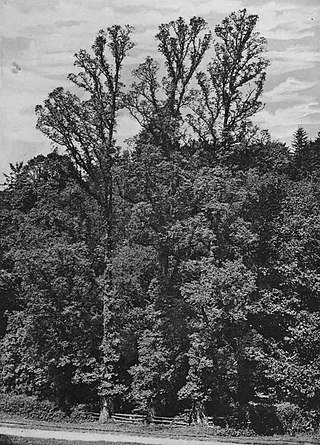
A lynx is any of the four extant species within the medium-sized wild cat genus Lynx. The name originated in Middle English via Latin from the Greek word lynx (λύγξ), derived from the Indo-European root leuk-, in reference to the luminescence of its reflective eyes.

Linaria is a genus of almost 200 species of flowering plants, one of several related groups commonly called toadflax. They are annuals and herbaceous perennials, and the largest genus in the Antirrhineae tribe of the plantain family Plantaginaceae.

The muskrat is a medium-sized semiaquatic rodent native to North America and an introduced species in parts of Europe, Asia, and South America. The muskrat is found in wetlands over various climates and habitats. It has crucial effects on the ecology of wetlands, and is a resource of food and fur for humans.

Acrididae, commonly called short-horned grasshoppers, are the predominant family of grasshoppers, comprising some 10,000 of the 11,000 species of the entire suborder Caelifera. The Acrididae are best known because all locusts are of the Acrididae. The subfamily Oedipodinae is sometimes classified as a distinct family Oedipodidae in the superfamily Acridoidea. Acrididae grasshoppers are characterized by relatively short and stout antennae, and tympana on the side of the first abdominal segment.

Aleuria aurantia is a widespread ascomycete fungus in the order Pezizales. The bright orange, cup-shaped ascocarps often resemble orange peels strewn on the ground, giving this species its common name.

The field elm cultivar Ulmus minor 'Stricta', known as Cornish elm, was commonly found in South West England, Brittany, and south-west Ireland, until the arrival of Dutch elm disease in the late 1960s. The origin of Cornish elm in the south-west of Britain remains a matter of contention. It is commonly assumed to have been introduced from Brittany. It is also considered possible that the tree may have survived the ice ages on lands to the south of Cornwall long since lost to the sea. Henry thought it "probably native in the south of Ireland". Dr Max Coleman of Royal Botanic Garden Edinburgh, arguing in his 2002 paper on British elms that there was no clear distinction between species and subspecies, suggested that known or suspected clones of Ulmus minor, once cultivated and named, should be treated as cultivars, preferred the designation U. minor 'Stricta' to Ulmus minor var. stricta. The DNA of 'Stricta' has been investigated and the cultivar is now known to be a clone.
Julyan Holmes is a Cornish scholar and poet. Born in 1948, Holmes has worked on such topics as Cornish placenames, the Prophecy of Merlin of John of Cornwall, and the writings of the Penwith School.

Great Britain is an island in the North Atlantic Ocean off the north-west coast of continental Europe, consisting of the countries England, Scotland and Wales. With an area of 209,331 km2 (80,823 sq mi), it is the largest of the British Isles, the largest European island and the ninth-largest island in the world. It is dominated by a maritime climate with narrow temperature differences between seasons. The island of Ireland, with an area 40 per cent that of Great Britain, is to the west—these islands, along with over 1,000 smaller surrounding islands and named substantial rocks, form the British Isles archipelago.
The Bishop of St Germans is an episcopal title which was used by Anglo Saxon Bishops of Cornwall and currently in use in the Church of England and in the Roman Catholic Church.
Charles Chorley was an English journalist, man of letters and translator from several languages.
Edward Hearle Rodd was an English ornithologist. He was the third son of Edward Rodd, D.D. (1768–1842), by his wife Harriet, (1779–1855) daughter of Charles Rashleigh, of Duporth, Cornwall.

Geopyxis carbonaria is a species of fungus in the genus Geopyxis, family Pyronemataceae. First described to science in 1805, and given its current name in 1889, the species is commonly known as the charcoal loving elf-cup, dwarf acorn cup, stalked bonfire cup, or pixie cup. The small, goblet-shaped fruitbodies of the fungus are reddish-brown with a whitish fringe and measure up to 2 centimetres across. They have a short, tapered stalk.

Staphylococcus is a genus of Gram-positive bacteria in the family Staphylococcaceae from the order Bacillales. Under the microscope, they appear spherical (cocci), and form in grape-like clusters. Staphylococcus species are facultative anaerobic organisms.

The European rabbit or coney is a species of rabbit native to the Iberian Peninsula, western France, and the northern Atlas Mountains in northwest Africa. It has been widely introduced elsewhere, often with devastating effects on local biodiversity. Its decline in its native range due to myxomatosis, rabbit hemorrhagic disease, overhunting and habitat loss has caused the decline of the Iberian lynx and Spanish imperial eagle. It is known as an invasive species because it has been introduced to countries on all continents with the exception of Antarctica, and has caused many problems within the environment and ecosystems; in particular, European rabbits in Australia have had a devastating impact, due in part to the lack of natural predators there.
John of Cornwall, possibly called in Latin Johannes Cornubiensis or Johannes de Sancto Germano was a 14th-century scholar and teacher, author of the English grammar Speculum Grammaticale

The Field Elm cultivar Ulmus minor 'Goodyeri', commonly known as 'Goodyer's Elm', was discovered by John Goodyer in 1624 at Pennington near the Hampshire coast between Lymington and Christchurch. No old specimens are known to survive, but the tree is perpetuated by numerous root suckers, notably in the lanes about the Alice Lisle public house in the New Forest hamlet of Rockford. The tree has suffered misidentification in the centuries since its discovery, firstly by Philip Miller in his 'Gardeners' Dictionary' of 1731, and later in the early 20th century by Augustine Henry and Marcus Woodward, who both confused the tree with Plot Elm, whose centre of distribution is in the East Midlands, some 200 miles away and of completely different appearance.

Fallow deer is the common name for species of deer in the genus Dama of subfamily Cervinae.

Melastiza chateri is a species of apothecial fungus belonging to the family Pyronemataceae.

Penhale Sands, or Penhale Dunes, is a complex of sand dunes and a protected area for its wildlife, on the north Cornwall coast in England, UK. It is the most extensive system of sand dunes in Cornwall and is believed to be the landing site of Saint Piran. Dating from the 6th century, St Piran's Oratory is thought to be one of the oldest Christian sites in Britain. The remains were discovered in the late 18th century, and in 2014 the covering sand was removed to reveal a building more than a thousand years old, in a reasonable state of preservation. A restricted military area dating from 1939, Penhale Camp, is found on the northern part of the dunes.
Staphylococcus cornubiensis is a species of Gram-positive cocci in the Staphylococcus intermedius Group (SIG): a group of genetically and phenotypically similar bacterial species that were previously identified as S. intermedius. The bacterium was first isolated from a human skin infection in Cornwall, United Kingdom. However, its presence in other species and/or pathologies has yet to be discussed in the literature. Another SIG bacterium, S. pseudintermedius, has also been implicated in cutaneous infections in humans–as a result of zoonotic transmission from domestic animals. The other SIG species have been isolated from various wild and domestic animals; such as dogs, cats, horses, camels, and dolphins, among others.













